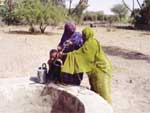Desertificación
Únicamente la versión en inglés ha sido aprobada por el Comité Científico de GreenFacts
Información sobre nuestra estructura de 3 niveles
3. Who is affected by desertification?
- 3.1 What is the geographical extent of desertification?
- 3.2 How vulnerable are affected populations?
- 3.3 Do impacts of desertification extend beyond drylands?
The source document for this study states:
"Desertification occurs on all continents except Antarctica and affects the livelihoods of millions of people, including a large proportion of the poor in drylands. Assessments of the extent of desertification vary, but even by conservative estimates it ranks among today’s greatest environmental challenges with serious local and global impacts."
Source & ©: MA ![]() Desertification Synthesis Report (2005),
Desertification Synthesis Report (2005),
Chapter 2, p.7
3.1 What is the geographical extent of desertification?
The source document for this study states:
"Geographical Extent of Desertification
Desertification is occurring in drylands all over the world. Estimates for total global dryland area affected by desertification vary significantly, depending on the calculation method and on the type of land degradation included in the estimate (C22 ![]() .4.1).
.4.1).
Despite the importance of desertification, only three exploratory assessments of the worldwide extent of land degradation are available. (See Key Question [How can we better understand the significance of desertification?] for more on the specific limitations of each study.)
- The most well known study is the Global Assessment of Soil Degradation from 1991 that estimated soil degradation based on expert opinion. It reported that 20% of the drylands (excluding hyper-arid areas) were suffering from human-induced soil degradation.
- Another estimate from the early 1990s, based primarily on secondary sources, reported 70% of drylands (excluding hyper-arid areas) were suffering from soil and or vegetation degradation.
- A partial-coverage assessment from 2003, developed as a desk study from partly overlapping regional data sets and remote sensing data, estimated that 10% of global drylands (including hyper-arid areas) are degraded.
Given the limitations and problems with each of the underlying data sets, the need for a better assessment is underscored. The actual extent of desertified area may lie between the figures reported by GLASOD and the 2003 study. That is, some 10–20% of drylands are already degraded (medium certainty). Based on these estimates, the total area affected by desertification is between 6 million and 12 million square kilometers. It follows that based on the total number of people threatened by desertification, this ranks among the greatest contemporary environmental problems (C22 ![]() .3.1, C22
.3.1, C22 ![]() .4.1)."
.4.1)."
Source & ©: MA ![]() Desertification Synthesis Report (2005),
Desertification Synthesis Report (2005),
Chapter 2, p.7-8
3.2 How vulnerable are affected populations?

Women often play a key role in water management in drylands (Mauritania)
Source: MA
The source document for this study states:
"Poverty and Vulnerability of the Affected Population
Dryland populations, at least 90% of whom live in developing countries, on average lag far behind the rest of the world in human well-being and development indicators. Compared with other systems studied in the MA, dryland populations suffer from the poorest economic conditions. The GNP per capita of OECD countries exceeds that of developing dryland countries almost by an order of magnitude. Similarly, the average infant mortality rate (about 54 per 1,000) for all dryland developing countries exceeds that for non-dryland countries (forests, mountains, islands, and coastal areas) by 23% or more. The difference is even starker—10 times higher—when compared with the average infant mortality rate in industrial countries. Two key indicators of human well-being in Asia are compared in Figure 2.1, in which drylands have the lowest GNP per capita and the highest infant mortality rates among the MA systems. It is found that the relatively low rate of water provisioning in drylands limits access to clean drinking water and adequate sanitation, leading to poor health (C22 ![]() .ES, C22
.ES, C22 ![]() .6).
.6).
Figure 2.1. Infant Mortality and GNP per Person in Drylands and Other Areas ![]()
The low level of human well-being and high poverty of dryland populations vary according to level of aridity and global region. This is further exacerbated by high population growth rates in drylands. For example, the population in drylands grew at an average rate of 18.5% during the 1990s—the highest growth rate of any MA system. A number of policy factors also contribute to the poor human well-being, such as political marginalization and the slow growth of health and education infrastructure, facilities, and services. The uneven level of these driving factors in various locations and at different times has diverse societal impacts across drylands. The worst situations can be found in the drylands of Asia and Africa; these regions lag well behind drylands in the rest of the world. (C22 ![]() .6.2, C6
.6.2, C6 ![]() .6).
.6).
Dryland populations are often socially and politically marginalized due to their impoverishment and remoteness from centers of decision-making.This holds true even in some indus-trial countries. As a consequence, these dryland populations are frequently unable to play a significant role in political decision-making processes. Their marginalization leads to reduced human security and increased vulnerability to factors of change, like drought (C22 ![]() .6)."
.6)."
Source & ©: MA ![]() Desertification Synthesis Report (2005),
Desertification Synthesis Report (2005),
Chapter 2, p.7-8
3.3 Do impacts of desertification extend beyond drylands?

A couple walks home during a dust storm in Xinlinhot, China
Source: MA
The source document for this study states:
"Regional and Global Consequences of Desertification beyond Drylands
Desertification has environmental impacts at the global and regional scale. Affected areas may sometimes be located thousands of kilometers away from the desertified areas. Desertification-related processes such as reduction of vegetation cover, for instance, increase the formation of aerosols and dust. These, in turn, affect cloud formation and rainfall patterns, the global carbon cycle, and plant and animal biodiversity. For example, visibility in Beijing is often adversely affected by dust storms originating in the Gobi Desert in springtime. Large dust storms emanating from China affect the Korean peninsula and Japan and are observed to even have an impact on North American air quality.
An increase in desertification-related dust storms is widely considered to be a cause of ill health (fever, coughing, and sore eyes) during the dry season.Dust emanating from the East Asian region and the Sahara has also been implicated in respiratory problems as far away as North America and has affected coral reefs in the Caribbean. (Dust storms can also have positive impacts, however; for example, air-transported dust deposits from Africa are thought to improve soil quality in the Americas). Finally, reduction of vegetation cover in drylands leads to destructive floods downstream and excessive clay and silt loads in water reservoirs, wells, river deltas, river mouths, and coastal areas often located outside the drylands (C22 ![]() .5.2, C14 Box 14.4, C12
.5.2, C14 Box 14.4, C12 ![]() .2.4, R11.3.2, R11.1.3).
.2.4, R11.3.2, R11.1.3).
The societal and political impacts of desertification also extend to non-dryland areas. Droughts and loss of land productivity are predominant factors in movement of people from drylands to other areas, for example (medium certainty). An influx of migrants may reduce the ability of the population to use ecosystem services in a sustainable way. Such migration may exacerbate urban sprawl and by competing for scarce natural resources bring about internal and cross-boundary social, ethnic, and political strife. Desertification-induced movement of people also has the potential of adversely affecting local, regional, and even global political and economic stability, which may encourage foreign intervention C22 ![]() .ES, C22
.ES, C22 ![]() .1.3, C22
.1.3, C22 ![]() .6.1, C22
.6.1, C22 ![]() .6.2)."
.6.2)."
Source & ©: MA ![]() Desertification Synthesis Report (2005),
Desertification Synthesis Report (2005),
Chapter 2, p.8


